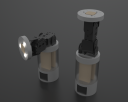Tetherlight is a hand held light that perpetually points at its sibling. Two Tetherlights constantly point at each other, guiding one Tetherlight to the other with a beam of light.
Tetherlight: Prototype 02 Rotation from che-wei wang on Vimeo.
The devices are each equipped with a GPS module, a digital compass, and a wireless communication module to locate, orient, and communicate its position to the other. They each calculate the proper alignment of a robotic neck to point a light in the other’s direction. In order to maintain the light’s orientation, an accelerometer compensates for the device’s tilt.
Tetherlights are for loving spouses, cheating spouses, girlfriends, boyfriends, children, pets, bags of money, packages, and pretty much anything that you would want to locate at a glance. An ideal use of Tetherlights would be in a situation where two people or two groups of people need to wander, but also need to locate one another in an instant. In a hiking scenario, a large group might spit up to accommodate different paces. With Tetherlights, understanding one’s whereabouts in relation to the other group is represented spatially with a bright light in the appropriate direction.
Tetherlight attempts to make one’s relation to a distant person more immediate by making a physical pointer instead of an abstract maps. With traditional maps, people need to communicate their positions, orient their maps, locate a point on the map, then look up in that direction. Tetherlight does it in an instant. The difference is like looking at a map to see where your uncle lives or having a string that’s always attached to him.
If you’re interested, here’s the Arduino Code: Tetherlight06xbeeGPS.pde





